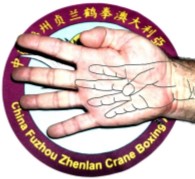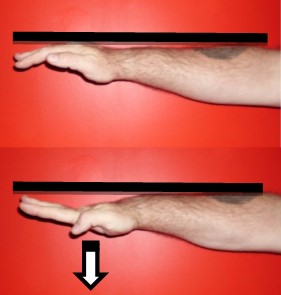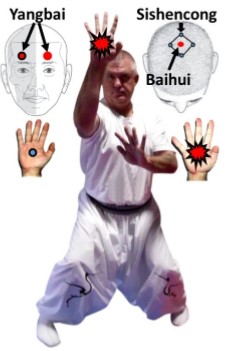“IRON SAND / CRANE PALM”
Within the White Crane Gongfu art this Hand Form is used more than any other. It is a Signature Characteristic of the style on an internal level. The Wu Bei Zhi states that one point for this attack is the “Fengchi” (Pool of Wind) Point struck in and downward on the nerve sending the energy down to the way the nerve itself has exited the body following this neural pathway. The strike can also be delivered upward & in towards the skull at a 45 degree angle causing loss of motor function & consciousness by directly attacking the Lesser Occipital Nerve.

The Iron Sand Palm uses a special Exploding transference of energetics into the desired target via the palm. Quickly splaying or extending the fingers causes the palm to generate an expansive energy upon impact resulting in a shock wave. Much like hitting water in a container causing a strong vibrational ripple effect!

The fingers are depicted as being “pulled” or “held” backwards …extended if you will, allowing the upper and lower palm areas to be extended forward into the strike. This teaches the initiated White Crane Gongfu practitioner that the Palm is “exploded” forward via the stretching or splaying of the fingers. This is one of the true Secrets of White Crane Gongfu and Dim Mak or Pressure Point / Blood Gate Striking …. Short, sharp, natural kinetic energy transfer ~ the Hallmark of true Original White Crane Gongfu! The palm “Explodes” onto the point and a slight “Twist” or tweaking action should also be used to transfer the kinetic energy into the area being struck.
The “Tianzhu” (Heavenly Pillar) point (Greater Occipital Nerve) can also be struck producing a similar response. As can the “Heavenly Window” – Tianchuang which is described as being a “Window of the Sky” point as it disrupts the opponents “Shen” or “Spirit” ….. one of the more deadly points of the Wu Bei Zhi’s dusty pages.
“Yinfeng” known as the “Shielding Wind” or “Wind Screen” point is a major point to be struck with this Hand Form.
Mentioned in the Wu Bei Zhi’s “Diagram of the Bronze Statue” 36 Points are listed. Amongst those points is the aforementioned “Yinfeng”. Here a secret is revealed ….. the name “Shielding Wind” or “Wind Field” relates to that of the Qi and the protection of same (Life Energy) so an attack here will be fatal.
It effects both the great auricularnerve and branches of the facial nerve.In terms of Traditional Chinese Medicine it is the intersection of the Triple Warmer and Gall Bladder Meridian with The Triple warmer being associated with the Fire Element and the Gall Bladder, the Wood element. Of course these are but a few of the areas that can be struck with this hand form.

This strike is used to attack the Sishencong points made up of four main points on the top of the head as well as the Baihui Point in the Centre. A strike can also be delivered with great effect to Yangbai (“Yang White”). One can clearly see the difference in the energetics of the Palms shown. The palm itself has transferred from a Yin to Yang state of energetics overloading the opponent’s body in term of the energetics. Yin Strikes will cause the opponents body to fold in and down while a Yang attack will cause the opponents body to open, lifting the feet off the floor in a less controlled fall and more volatile action. That used in the strike has the fingers splayed and the palm “pads” projected forwards adding kinetic percussive energy into the strike as per the illustration of the Iron Sand Fan Palm as seen within the Wu Bei Zhi




 Reply With Quote
Reply With Quote


